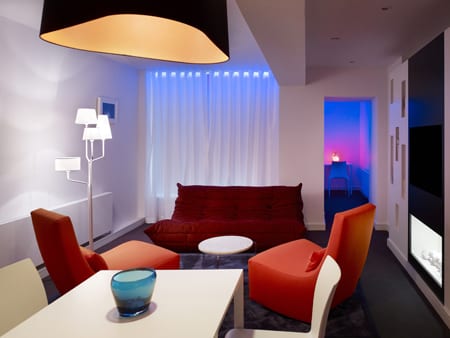You’d better not blink in Los Angeles, or you’ll risk losing your 15 minutes of fame. In this city filled with celebrity starlets and would-be limelighters, everything from jeggings to stardom can be reduced from “hot” to “not” status in the blink of an eye, including top-rated nightspots frequented by the A-list.
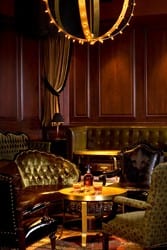 Aiming to take on Hollywood’s fickle nature and adequately armed with a unique concept in mind, Chosen Hospitality group partners Matthew Bendik and David Koral were ready to make their mark on the nightlife scene with a new club. The pair of young entrepreneurs took a risk and purchased a 4,500-square-foot historic building in West Hollywood, away from the glitz and glam of main street crowds. The then-vacant building had housed a variety of entertainment-oriented facilities since its legendary days as Peanuts, a local watering hole for the Rat Pack that had since fallen into disrepair.
Aiming to take on Hollywood’s fickle nature and adequately armed with a unique concept in mind, Chosen Hospitality group partners Matthew Bendik and David Koral were ready to make their mark on the nightlife scene with a new club. The pair of young entrepreneurs took a risk and purchased a 4,500-square-foot historic building in West Hollywood, away from the glitz and glam of main street crowds. The then-vacant building had housed a variety of entertainment-oriented facilities since its legendary days as Peanuts, a local watering hole for the Rat Pack that had since fallen into disrepair.
“We wanted to create a very exclusive, highly polished, unique experience,” says Bendik, managing partner of the new West Hollywood club they created, called Voyeur. “We wanted a very sexual connotation, one where the customer is almost intimidated to walk in, and the atmosphere is left open to the imagination.”
 Bendik and Koral approached New York-based designer Mark Zeff because of his unabashed penchant for seductive design and commissioned him to bring their vision to light. Voyeur burst onto the scene boasting a design that is one part rock star, three parts burlesque, and a dash of London vintage. “This was the first time that Los Angeles had a club that exuded a sense of authenticity in showing sensuality,” says Mark Zeff, founder of Mark Zeff Design, who drew inspiration from London’s Annabelle’s lounge and the movie Eyes Wide Shut. “The solution really came from the name. We ran with it and made a presentation that was very racy. Usually the clients will then water it down, but they actually went for the whole thing.”
Bendik and Koral approached New York-based designer Mark Zeff because of his unabashed penchant for seductive design and commissioned him to bring their vision to light. Voyeur burst onto the scene boasting a design that is one part rock star, three parts burlesque, and a dash of London vintage. “This was the first time that Los Angeles had a club that exuded a sense of authenticity in showing sensuality,” says Mark Zeff, founder of Mark Zeff Design, who drew inspiration from London’s Annabelle’s lounge and the movie Eyes Wide Shut. “The solution really came from the name. We ran with it and made a presentation that was very racy. Usually the clients will then water it down, but they actually went for the whole thing.”
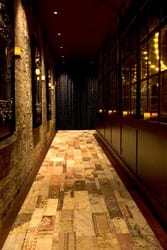 Upon entering Voyeur, “people go through a phase of discovery, experiencing the venue layer by layer,” says Bendik. Guests are greeted in the Jewel Box-a small, entry space-and led by a hostess down a hall to the nightclub’s main space. The passageway features the building’s original exterior brick wall adorned with antique mirrors on the left and glass partitions on the right. The window-like element, salvaged from 1920s glass casement windows from the old New York Times building on West 43rd Street in New York, give only tantalizing glimpses into the mystery caged inside.
Upon entering Voyeur, “people go through a phase of discovery, experiencing the venue layer by layer,” says Bendik. Guests are greeted in the Jewel Box-a small, entry space-and led by a hostess down a hall to the nightclub’s main space. The passageway features the building’s original exterior brick wall adorned with antique mirrors on the left and glass partitions on the right. The window-like element, salvaged from 1920s glass casement windows from the old New York Times building on West 43rd Street in New York, give only tantalizing glimpses into the mystery caged inside.
Turning the corner of the hallway, Voyeur’s main space offers full immersion into an sensation of sexuality. The antique, wooden bar lies straight ahead as a focal point, exuding an air of Victorian luxury, while refurbished wood panels, collected from an old barn in Westchester, New York, give statement to the walls. Oversized, spherical chandeliers with spiked lights create the illusion of flickering candlelight. A large, black trapeze net gracing the ceiling creates a backdrop for the female models to provocatively entice the crowd from above. The atmosphere is always dynamic, intriguing, and unmistakably sexy.
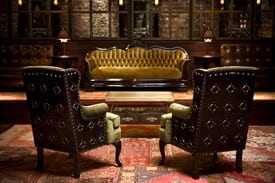 The lounge features a collection of mismatched, antique seating pieces that are custom upholstered; dark green and black leather call out to be touched and felt. Each piece portrays its own personality. Seductive details play on elements of femininity and masculinity, such as crisscross lacing up the back that mimics corset lingerie or the small brass rings and bronze elements that boast an aura of testosterone. Dark leather drapery with brass ring details exploits the sexuality of the space, while a hippie-style patchwork carpet, made from old Persian carpet remnants, covers the floor. To the far-end of the club, a stage for performances backs the exterior patio. A glass encasement box, which serves to disguise the requisite 18 subwoofer speakers, hosts vignettes and other small acts.
The lounge features a collection of mismatched, antique seating pieces that are custom upholstered; dark green and black leather call out to be touched and felt. Each piece portrays its own personality. Seductive details play on elements of femininity and masculinity, such as crisscross lacing up the back that mimics corset lingerie or the small brass rings and bronze elements that boast an aura of testosterone. Dark leather drapery with brass ring details exploits the sexuality of the space, while a hippie-style patchwork carpet, made from old Persian carpet remnants, covers the floor. To the far-end of the club, a stage for performances backs the exterior patio. A glass encasement box, which serves to disguise the requisite 18 subwoofer speakers, hosts vignettes and other small acts.
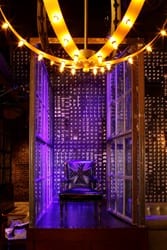 “To me it’s Jimmy Paige’s house or some sort of rock ‘n’ roll manor home rather than a nightclub,” Zeff says. “I think that the overall aspect of material, lighting, and layout helps one get over the obvious, in-your-face image. The careful use of lighting and art is a huge reason why this place does not feel like a movie set.”
“To me it’s Jimmy Paige’s house or some sort of rock ‘n’ roll manor home rather than a nightclub,” Zeff says. “I think that the overall aspect of material, lighting, and layout helps one get over the obvious, in-your-face image. The careful use of lighting and art is a huge reason why this place does not feel like a movie set.”
A smaller, private, VIP room off the main bar holds even more design intrigue, thanks to the eye-catching erotic custom photography on the walls, which helps develop the room’s palette. Some of the image negatives are found in the main room as noir wallpaper.
But the success of Voyeur is not simply because of the design’s brazen and unconventional flaunting of the risqué. Rather it’s the club’s ability to exude a sense of authenticity in showcasing sexuality to provide a truly submersive experience-and that was more than enough to elicit attention from countless media and Hollywood’s hottest stars over the past year.
“Voyeur is about being a fantasy in one’s mind. I think that’s why it’s so successful,” says Zeff. “You go there, and you feel elevated with the lighting and the intimacy. That’s why it works.” It’s nothing less than voyeuristic, from A to Z.
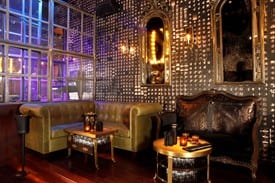 Voyeur, West Hollywood
Voyeur, West Hollywood
Owner: Chosen Hospitality
Interior designer: MARKZEFF/ NYC
Wallcoverings: Unica Home, Paul Marra Design
Paint: Benjamin Moore
Carpet/carpet tile: Eliko Oriental Rugs, Sacco
Ceiling: CSN Mirrors
Lighting: Circa, Vaughan, Off the Wall antiques, Reborn Antiques Distribution, Gray Morelli
Doors: Pine Crest
Glass: Net Shops
Window treatments: Kravet
Lounge/other seating: Argent. Custom Furniture and Horseman Antiques
Upholstery: Kravet, Moore and Giles, Fabricut
Bars: Architectural Antique Exchange
This story originally appeared in Contract, Hospitality Design’s sister publication.


